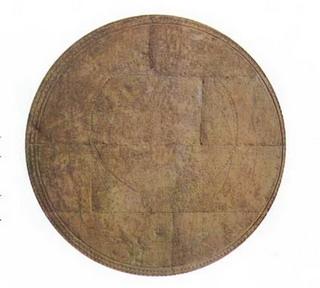Source: Inner Mongolia News
07-23-2007 18:56
 |
The only one Mongolian stone inscription astronomic chart known by present recorded in China's astronomic historical recordation is still kept on the rear screen wall of "Guardian Warriors Dagoba" in Wuta Temple, Yuquan District of Hohhot.
The chart is also called as Gaitian Chart. With a diameter of 1.445 m, it recorded 270 fixed stars and above 1550 stars. 28 constellations, the Arctic Circle, the Antarctic Circle, the Summer Solstice Circle, the Winter Solstice Circle and the Zodiacal Circle are clearly marked.
In the part of Legend, seven stars are put in a column and the grade of the star is marked at the right side in Mongolia. According to related experts, according to the affix of "Formulated by Qintianjian (the institution specially in charge of astronomy and geography in Qing Dynasty", the chart must be an official one in the Qing Dynasty.
With China's traditional drawing style dominating, the chart used common names for constellations. It also absorbed some abroad astronomic knowledge introduced in late Ming and early Qing Dynasties. For example, it depicted 68 stars on 15 constellations nearly the South Pole, which can't be found on astronomic chart before the Ming Dynasty.The knowledge absorbed from abroad was adapted according to the requirement of China to comply with traditional astronomic system and become an intrinsic part of Chinese astronomy.
Deducting by the contents and precession, the chart must be formulated during the reign of Emperor Qianlong on the base of the chart formulated during the reign of Emperor Kangxi as it complied with Yixiang Kaocheng. In this period, Mongolian scientist Ming Antu served in Qiantianjian and was responsible to compile Yixiang Kaocheng. Therefore, the chart is possibly made by Ming Antu.
Mongolian stone inscription astronomic chart is the only astronomic chart marked in Mongolian in the world, it is the historical witness of the outstanding contributions in astronomic field by ethnic groups in north China.
Editor:Chen Ge
